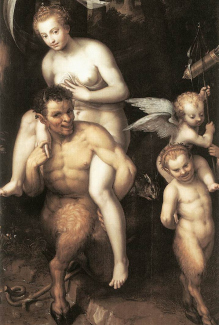Saiyr, other than rendered as satyr, is also translated as "hairy" (Genesis 27:11, 23, etc.), "goat" (Leviticus 4:24, 9:15, etc.), a "kid" of the goats (Genesis 37:31, Leviticus 4:23, etc.) and even "devils" (Leviticus 17:7) in other places in Scripture.
But wild beasts of the desert shall lie there; and their houses shall be full of doleful creatures; and owls shall dwell there, and satyrs shall dance there (Isaiah 13:21, KJV).
The wild beasts of the desert shall also meet with the wild beasts of the island, and the satyr shall cry to his fellow; the screech owl also shall rest there, and find for herself a place of rest (Isaiah 34:14, KJV).
The only characteristics of this animal mentioned in Scripture is their ability to dance (Isaiah 13:21) and cry out (34:14). Some Biblical commentaries, based on the use of saiyr in other parts of God's word, believe these two verses refer either to mythological beasts or to wild or shaggy goats.

Some translations of the twenty-first verse of Isaiah 13 do support the supposition that saiyr is better translated as a type of goat.
But desert creatures will lie there, jackals will fill her houses; there the owls will dwell, and there the wild goats (satyrs) will leap about (Isaiah 13:21, NIV).
In mythology these beasts were half-human and half animal. They possessed the head of a man (with horns) and torso of a human but had the legs and feet of a goat.
Devils and Babylon
Evidence suggests that saiyr, used in chapters 13 and 34 of Isaiah, has a deeper meaning than merely referencing goats or even mythical satyrs. The Living Bible translation of the verses in question hints at this meaning.
The wild animals of the desert will make it (ancient Babylon) their home. The houses will be haunted by howling creatures. Ostriches will live there, and the DEMONS (saiyr) will come there to dance (Isaiah 13:21, TLB).
The wild animals of the desert will mingle there with wolves and hyenas . . There the NIGHT-MONSTERS will scream at each other, and the DEMONS will come . . . (34:14, TLB).
The immediate context of Isaiah 13:21 is God's destruction of Babylon at the hand of the Medes and his promise to make the city desolate (see 13:1 and verses 17 - 22). This chapter also presents a type or shadow of God's end time judgment to come upon on earth because of the Babylon-like system that will govern all humans (compare Isaiah 13:6 - 13 to Revelation 6, 8, 9, 16, 17:5, etc.). Isaiah 34 discusses God's future judgment on the entire world because of Babylon the Great (Revelation 14:8, 18:10, etc.).
In Revelation 18 an angel comes down from heaven to cry out to the entire earth that Babylon the great has fallen "and is become the habitation of DEVILS" (Revelation 18:2, KJV) and of every unclean (unfit to eat) bird.
John Gill's Exposition of the Entire Bible explains Revelation 18:2 as "Babylon the Great" becoming "the habitation of devils; as old Babylon was of satyrs, Isaiah 13:21 demons, which appeared in a hairy form, like goats."
Albert Barnes Notes on the Bible states that verse 2 of Revelation 18 is "in allusion to the common opinion that the demons inhabited abandoned cities, old ruins, and deserts . . . The language here is taken from the description of Babylon in Isaiah 13:20 - 22."